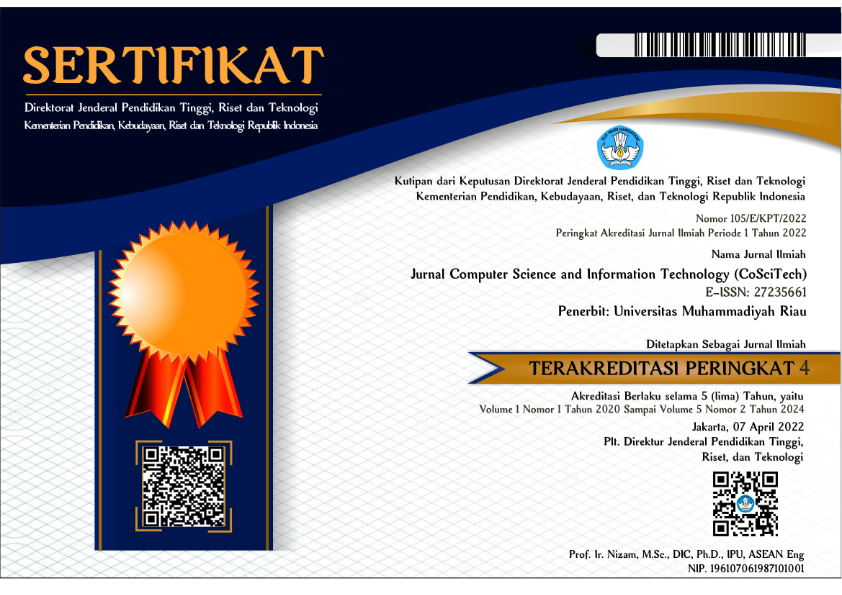Sistem otomatisasi pada tanaman hidroponik deep flow technique menggunakan IoT berbasis web
DOI:
 https://doi.org/10.37859/coscitech.v4i2.5078
https://doi.org/10.37859/coscitech.v4i2.5078
Abstract
Hydroponics is a farming method that does not use soil as a place to grow plants, but instead uses water that contains the nutrients needed by plants. One of the plants that can be cultivated using hydroponic techniques is spinach. The disadvantage of applying this technique is that it requires precision, patience, and continuous monitoring. To overcome this problem, you can take advantage of technological advances that have developed. Currently there are many systems that are capable of processing and doing human work that is done manually to make it easier, faster and more accurate both in terms of time and effort. So a spinach cultivation system was built on Deep Flow Technique hydroponics based on the Internet of Things. This study uses a prototype system development method that is designed using several components, namely Arduino Uno as the system control center, pH sensor as nutrient pH input, TDS sensor as nutrient concentration input, and ultrasonic sensor as water level input. The results of this study are systems that can monitor, automate and control the provision of nutrients to hydroponic plants. Information about plants will be sent via the website, so that it can make it easier to check the condition of the plants.
Downloads
References
[2] S. Karim, I. M. Khamidah, and Y. Yulianto, “Sistem Monitoring pada Tanaman Hidroponik menggunakan Arduino UNO dan NodeMCU,” Buletin Poltanesa, vol. 22, no. 1, pp. 75–79, 2021.
[3] N. S. Wibowo, M. Aziziah, I. G. Wiryawan, and E. Rosdiana, “Desain Sistem Informasi Monitoring Nutrisi Tanaman Hidroponik Kangkung dengan Menggunakan Metode Regresi Linear,” Jurnal Ilmiah Inovasi, vol. 22, no. 1, pp. 51–58, 2022.
[4] M. G. N. Eoh, J. Andjarwirawan, and R. Lim, “Sistem Kontrol dan Monitoring Ph Air serta Kepekatan Nutrisi pada Budidaya Hidroponik Jenis Sayur dengan Teknik Deep Flow Techcnique,” Jurnal Infra, vol. 7, no. 2, pp. 101–106, 2019.
[5] A. D. Purwanto, F. Supegina, and T. M. Kadarina, “Sistem Kontrol Dan Monitor Suplai Nutrisi Hidroponik Sistem Deep Flow Technique (DFT) Berbasis Arduino NodeMCU Dan Aplikasi Android,” Jurnal Teknologi Elektro, vol. 10, no. 3, pp. 152–158, 2019.
[6] B. WN, “Tabel PPM dan pH Nutrisi Hidroponik,” Hidroponik Pedia, 2016. http://hidroponikpedia.com/tabel-ppm-dan-ph-nutrisi-hidroponik/ (accessed Feb. 05, 2023).
[7] H. Arfandy, “Rancang bangun sistem informasi pariwisata Sulawesi Selatan berbasis android dengan menggunakan metode Prototyping,” SINTECH (Science and Information Technology) Journal, vol. 3, no. 1, pp. 70–76, 2020.
[8] U. L. Usnul and Z. Alamsyah, “Implementasi fuzzy mamdani sebagai pendukung keputusan pada sistem monitoring air layak konsumsi,” Jurnal CoSciTech (Computer Science and Information Technology), vol. 4, no. 1, pp. 15–24, 2023.
[9] Z. Buana, O. Candra, and E. Elfizon, “Sistem pemantauan tanaman sayur dengan media tanam hidroponik menggunakan arduino,” JTEV (Jurnal Teknik Elektro Dan Vokasional), vol. 5, no. 1, pp. 74–80, 2019.
[10] A. Fauzan and R. Fahlefie, “SISTEM MONITORING HIDROPONIK BERBASIS ARDUINO UNO,” Jurnal Ilmiah Mahasiswa Kendali dan Listrik, vol. 3, no. 1, pp. 84–94, 2022.
[11] Siti Olis and Somantri, “Penerapan logika fuzzy mamdani pada sistem penyiram tanaman stroberi otomatis berbasis mikrokontroler,” Jurnal CoSciTech (Computer Science and Information Technology), vol. 4, no. 1, pp. 33–41, Apr. 2023.














